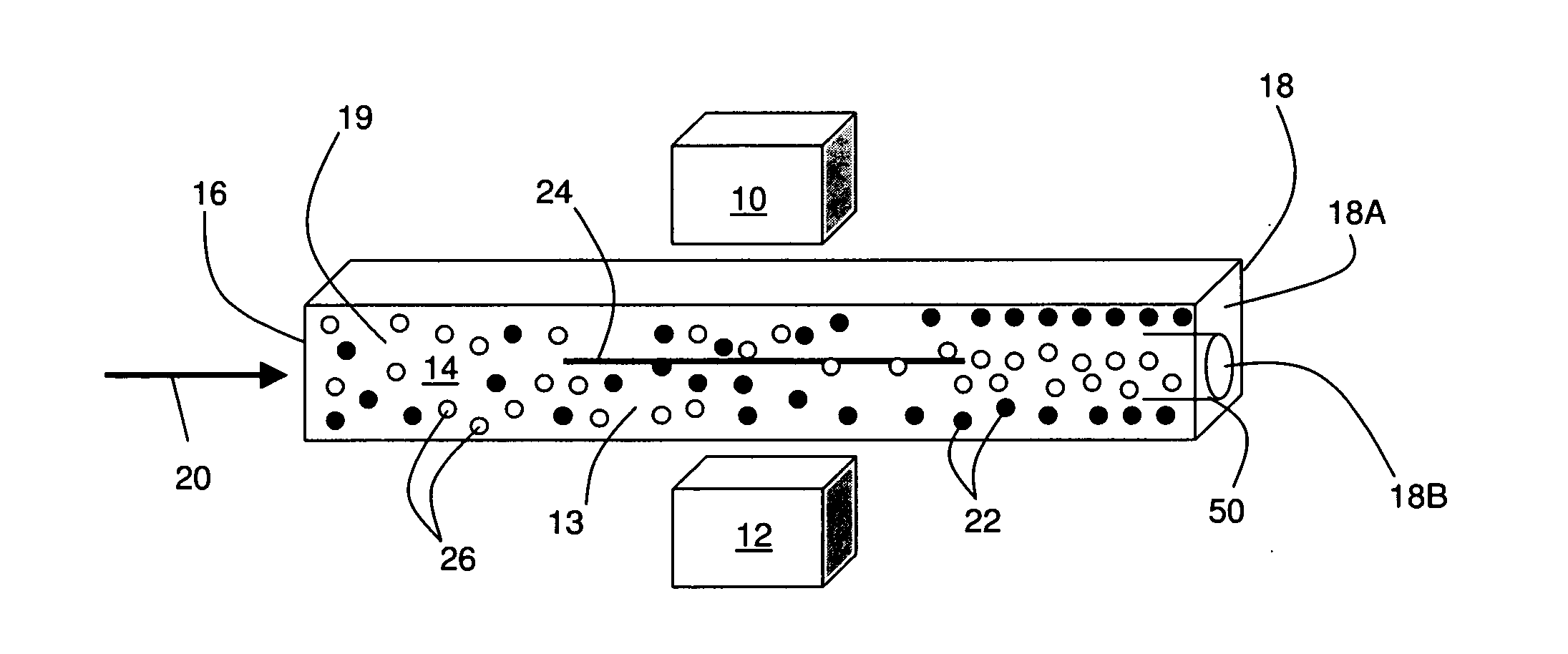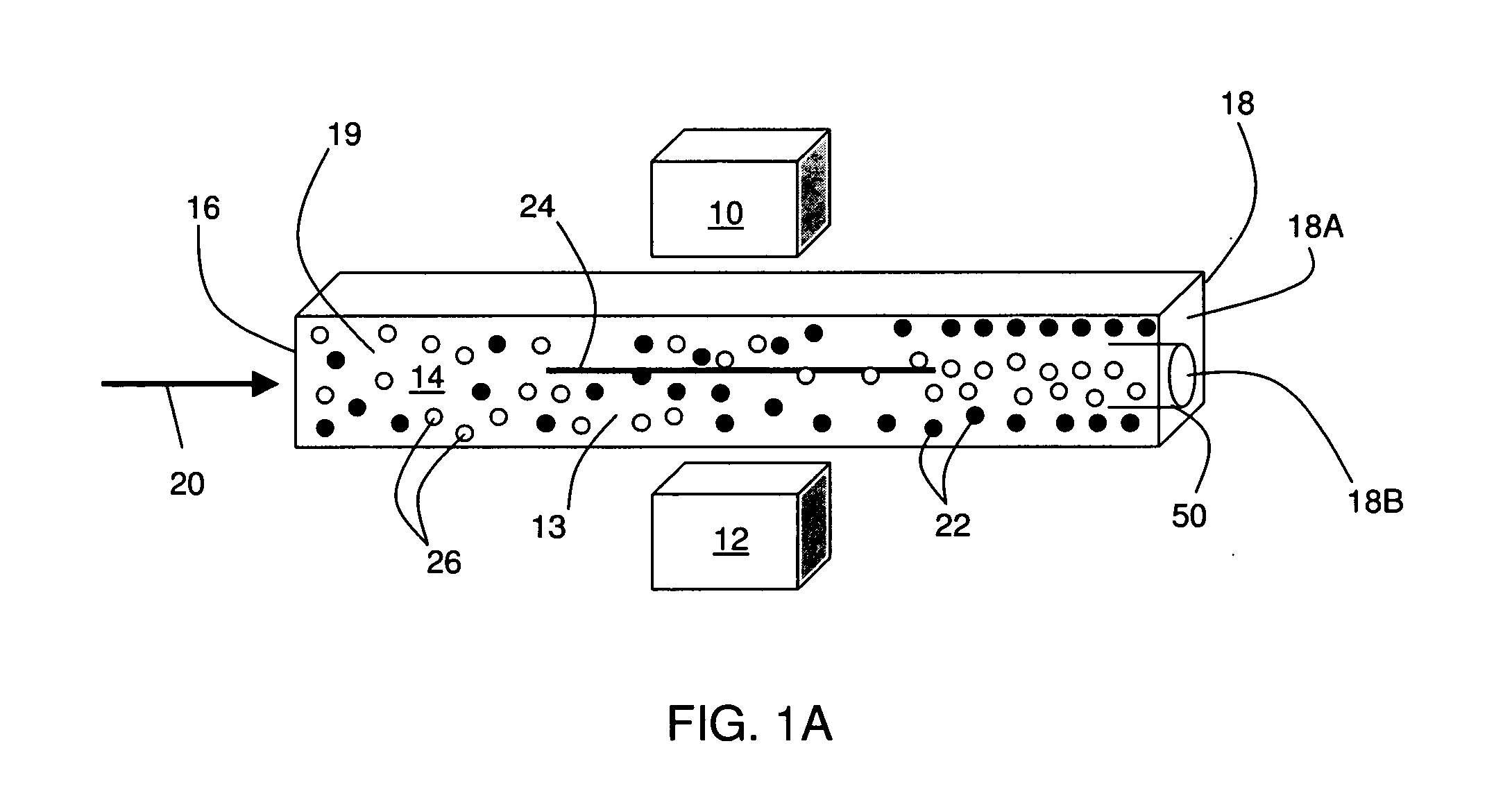Manipulation of particles in channels
- Summary
- Abstract
- Description
- Claims
- Application Information
AI Technical Summary
Benefits of technology
Problems solved by technology
Method used
Image
Examples
example 1
[0075]In this example, magnets were arranged around a channel to produce a magnetic field including a region having zero magnetic field intensity within the channel. Such arrangements may be used to separate non-magnetic particles from solutions of magnetic particles, as is discussed herein.
[0076]Two rectangular permanent magnets (length L, width w, thickness d) were arranged in parallel such that the magnetization vectors of the two magnets pointed in opposite directions without facing each other directly (see FIG. 9). This arrangement created a region having zero magnetic field intensity on the line of symmetry between the two magnets.
[0077]Simulated magnetic field diagrams were produced using Mathematica. FIGS. 11A-11C show plots of the total magnetic field Btot [x, y, z] for the following cases: Btot[0,0,z] vs. z, Btot[0,y,0] vs. y, and Btot[x,0,0] vs. x. FIGS. 12A-12C show contour plots of the magnetic potential for the following cases: Btot[0,y,z] in the yz-plane, Btot[x,y,0] ...
example 2
[0079]In this example, an example illustrating manipulating non-magnetic particles within a solution of paramagnetic ions is described. In this example, polystyrene beads with diameters of 10 to 15 microns were used as non-magnetic particles. The beads were mixed with a 200 mM solution of Gd-DTPA (diethylene triamine pentaacetic acid), to a concentration of 0.0001% solid components by weight. The solution was transported at volumetric flow rates of 1-2 microliters per minute. The magnets were aligned with the centers of the sidewalls of the capillary tube.
[0080]FIG. 13A includes a cross-sectional schematic illustration of the experimental setup used in this example. The magnets and capillary were mounted into a PMMA (poly(methyl methacrylate)) structure in order to produce an overlapping magnetic field with a magnetic field zero at the center plane of the channel. The permanent magnets had dimensions of 1.6 mm×3.2 mm×25 mm and surface fields of 0.4 T. The square glass capillary had ...
example 3
[0082]In this example, the movement of non-magnetic particles is theoretically described, although it should be understood that this theory is presented by way of illustration only, and is not intended to be limiting in any way. In this example, the movement of magnetic particles away from the magnetic field minimum (toward regions comprising high magnetic fields) may force the non-magnetic particles toward the magnetic field minimum. This effect may be used, for example, to produce relatively concentrated populations of magnetic and non-magnetic particles, as described above.
[0083]The force on a non-magnetic particle in a solution of paramagnetic ions may be expressed as:
Fm=(χf-χo)μ0C·V·(B·∇)B[1]
where (chi)o represents the susceptibility of the particles, (chi)f is the susceptibility of the paramagnetic ions, (mu)o is the permeability of vacuum, C is the concentration of the paramagnetic ions, V is the volume of the particle, and B is the magnetic field. This equation holds under t...
PUM
| Property | Measurement | Unit |
|---|---|---|
| Fraction | aaaaa | aaaaa |
| Fraction | aaaaa | aaaaa |
| Fraction | aaaaa | aaaaa |
Abstract
Description
Claims
Application Information
 Login to View More
Login to View More - R&D
- Intellectual Property
- Life Sciences
- Materials
- Tech Scout
- Unparalleled Data Quality
- Higher Quality Content
- 60% Fewer Hallucinations
Browse by: Latest US Patents, China's latest patents, Technical Efficacy Thesaurus, Application Domain, Technology Topic, Popular Technical Reports.
© 2025 PatSnap. All rights reserved.Legal|Privacy policy|Modern Slavery Act Transparency Statement|Sitemap|About US| Contact US: help@patsnap.com



